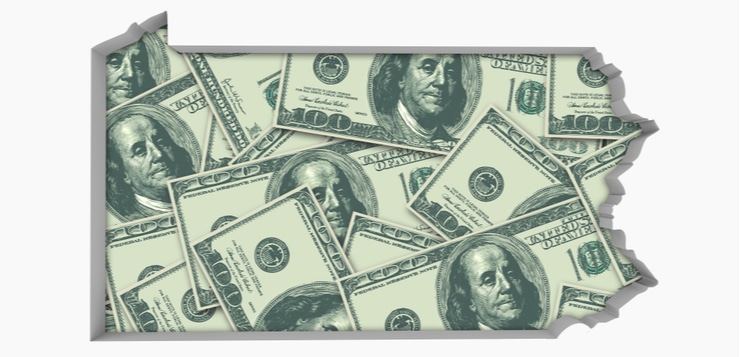Pandemic or not, Pennsylvania is on pace to generate a record $4 billion in gaming revenue in 2021.
The financial report released by the Pennsylvania Gaming Control Board last week showed that not only was March the first month in which revenue from all sources surpassed $400 million, but it marked the first quarter in which they exceeded $1 billion.
The nearly $1.02 billion from the combination of online and retail slots, table games, sports betting, VGTs, and fantasy sports contests in January-March translates into $4.06 billion over the course of the year if it keeps up, and it appears more likely the revenue will only increase. The state’s prior high was $3.41 billion in 2019.
The record gambling level has translated into $416.8 million in government revenue thus far in 2021 in a comparatively high-tax state that reaps the most from gaming in the country for state and local budgets.
At a blended tax rate of a little over 40% when all forms of gambling are counted together, governments apparently can count on collecting at least $1.6 billion from it in the full year. That money is used for multiple purposes, primarily supporting state and local general funds; boosting economic development; reducing local property taxes; and subsidizing the horse racing industry.
The table below shows the amount earned by gaming operators for each form of gambling in the first quarter and how that rate would equate to a full year:
| Time Frame | Slots | Table games | iCasinos | Sports betting | VGTs/Fantasy Sports | Total |
|---|---|---|---|---|---|---|
| March | $199.3 million | $71.4 million | $97.7 million | $29.4 million | $5.4 million | $403.1 million |
| January-March | $485.9 million | $179.6 million | $255.9 million | $79.8 million | $15 million | $1.02 billion |
| 2021 Projection | $1.94 billion | $718.4 million | $1.02 billion | $319.2 million | $60 million | $4.06 billion |
Numbers should only grow, not shrink
Of course, any projections for the full year depend on the casino and sports betting industries avoiding anything like the COVID-related shutdowns that cost them so much in 2020, when revenue of $2.65 billion was down 22.2% from the year before.
There are sound reasons, however, to believe revenue streams will only pick up during the remainder of 2021 rather than decline.
- As vaccination rates have picked up, the universe of potential gambling patrons seems to have returned to a comfort level with large gatherings in casinos. Combined slots and table game revenue within casinos of $270.7 million in March was down 12.4% from the last comparable March in 2019 (casinos were shut down half of March 2020), but that was far less than the retail drops in prior months.
- The lifting of alcohol service restrictions and easing of capacity limits (to 75% from 50%) by the state on April 4 means that for many people — especially younger adults — casinos can return to the more festive, party-like atmosphere that draws crowds, especially on weekends. The record March revenue was generated while there were still no bars open or alcohol service on casino floors.
- The revenue in the first quarter largely came from 14 brick-and-mortar casinos, 14 iCasinos, and 12 online/mobile sportsbooks. Sometime this year, operators are expecting to add — at the very least — two more mini-casinos in York and Berks counties, another iCasino from Boyd Gaming Corp., a PointsBet digital sportsbook, and one or more additional online poker sites. [Update: Boyd’s Stardust online casino became operational Monday after this article was written.]
One other uncertainty in projections besides COVID is the possibility that as more gamblers return to casino visits, it could reduce the volume of online casino play. The iGaming revenue numbers soared a year ago as the pandemic began forcing people to stay at home.
Still, the March iCasino revenue of $97.7 million was so far above the prior high — $80.4 million in January — that it seems unlikely that type of gaming will fall substantially. The $255.9 million earned over the first three months of 2021 means the operators collectively could receive more than $1 billion this year from players’ losing wagers by computer and phone on slots, tables, and poker.
PA leads in tax revenue, but Nevada leads overall
Even at its current pace, Pennsylvania is far from taking over from Nevada as the nation’s leading generator of income from gambling — even though the higher tax rate in the Keystone State means governments gain more direct benefit from it.
Nevada’s gaming revenue was reported as $6.75 billion in the COVID-impacted year of 2020, down substantially from an all-time peak of $11.6 billion in 2018.
Pennsylvania’s revenue is more comparable to that of New Jersey, a state that Pennsylvania has emulated more than any other. The Keystone State followed in its neighbor’s footsteps with broad expansion into online casinos and sports betting made possible by 2017 state legislation and a 2018 U.S. Supreme Court decision.
In 2019, when Pennsylvania achieved its high of $3.41 billion from all gaming, New Jersey generated $3.47 billion. Like Pennsylvania, New Jersey suffered a COVID-related decline last year but can be expected to set a new record this year.
One thing Pennsylvania’s expansion did that has not been the case in New Jersey was add to the number of physical casinos and revenue from them.
Two Live! casinos of the Cordish Gaming Group have been the ones to open so far, in Philadelphia and Westmoreland County. In March, the Philadelphia property earned $20 million from slots and table games, and its satellite mini-casino across the state cleared $8.2 million.
Over the course of a year at that rate, those two combined would amount to $338.4 million in new revenue. That number will likely end up still higher due to the lifting of alcohol restrictions and additional patronage in the casinos as the pandemic eases.






